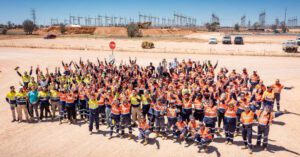In the end, she fought to the last – as if indignant at the very suggestion that she was old, decrepit and unreliable. Unit 1, the last one standing of the four 500MW nameplate units at the Liddell coal generator in the Hunter Valley, Australia’s oldest coal plant, didn’t want to go out quietly.
Engineers had expected it to drop from its last hold point of around 70MW to zero output pretty quickly, but it simply wouldn’t go.
And they were surprised it hung around for as long as it did. So, just before 10.30am on Friday morning, Steve Lanesbury, a 44-year veteran of the Liddell plant, eventually had to push the button he didn’t want to push to close it down.
“We were wondering, why is she still going?” Lanesbury said shortly afterwards, emotion in his eyes and voice. “It went on bit longer than we expected. Generally they trip out before then and she just didn’t want to go.

“We were saying (in the control room) that we have never seen anything like it, we’re basically trying to switch her life support system off so she could go by herself, but we couldn’t do that in the end. So we actually had to push the button, which was a bit sad.”
As the assembled media quietly peered and pointed their cameras through the open windows of the ancient control room, more than a dozen Liddell workers that had gathered in the small room for the occasion hugged and shook hands. There hardly seemed a dry eye in the room.
Lanesbury, who will now retire after starting at the plant as a 16-year-old apprentice, said there was a lot of emotion in that control room – and across the whole Liddell community – as the last unit was shut down. “I’ve had my career, and she’s had her career. Yes, I’m gonna go out with her.”
The closure of Liddell may have become a political football, and a landmark moment in Australia’s green energy transition, but for the people who work here – some for their entire careers – it is a very big day.

Liddell might have been tarnished – including by its own owners as being old and decrepit in its last years – but it was once the country’s biggest generator.
And for all the controversy about its emissions and environmental impact, it was more than just a machine to the people who worked there for a lifetime and the communities that depended on it.
“It’s tough,” said Graeme McNeil, who was also in the control room at the closure and who has worked at Liddell for his entire 42-year working life. “I feel like a cry, but I’m worried it might cause a bit of a chain reaction.”
AGL boss Damien Nicks was also in the control room to watch the last half hour of generation and to witness the switching off of the last unit. Another unit had been closed down on Wednesday and another on Monday. The first unit was shuttered a year ago.

AGL says it could no longer keep Liddell working even if it wanted to, because at 51-years-old it had well exceeded its operating life and it was clear, as the company hosted a media tour on the last day, that this is ageing machinery that would be impossible or too expensive to maintain.
It will now be recycled – there are some 70,000 tonnes of steel in the plant, more than the Sydney Harbour Bridge – so some of it may come back as wind towers or solar mountings. Or as part of an electric vehicle.

Lanesbury says he will now retire, and McNeil will go over the road to the neighbouring Bayswater coal generator until he turns 60, and then he will retire too.
The big difference from 10 years ago, however, is that AGL is offering those that want it a future as the company transforms the vast Liddell-Bayswater complex to a green industrial hub, with a big battery, green hydrogen, and solar thermal and other industries likely to find a role on site.
“You probably saw, yourselves, the real emotion in the control room from all of our workers,” Nicks told journalists later.
“But this is just a start. Over the next couple of years we’ll be getting it ready for rehabilitation. But then importantly, it’s about turning this into an industrial energy hub.

“We will be bringing batteries on board, and other forms of industry, solar wind, but also now looking at waste energy, and green hydrogen as well.
“So there’s a whole range of things. This is a fantastic site, great infrastructure and access to the grid. So we’ll continue to be here for many decades to come.”
Nicks says the first investment will almost certainly be the Liddell battery, with a decision to be made in the next nine months on how big it is – likely to be 500MW, and one, two or four hours of storage.
Big batteries are springing up everywhere. This week AGL started operations on the Torrens Island battery, built at the site of its ageing gas generators in South Australia, and is building a 50MW/100MWh battery at Broken Hill. A big battery at the Tomago smelter is also a possibility.
At Liddell, solar thermal technology – through RayGen – is also a possibility. The equipment built for the ill-fated solar thermal plant at Liddell that was supposed to provide added steam but was never switched on remains on site.
Discussions continue with Andrew Forrest’s Fortescue Future Industries over green hydrogen plans, and AGL is also looking at wind opportunities, and the Bells Mountain pumped hydro project, to add to the future green energy mix.

“Wherever we can, we’ll try and connect into this site as best as we can,” Nicks told journalists later. AGL’s current plan is to close Bayswater in 2033 and Loy Yang A in Victoria in 2035.
But those plans could change. AGL’s latest timeline is consistent with a 1.8°C climate outcome, and there will be pressure on going harder and closer to 1.5°C. That would require the remaining coal plants to be closed by the end of the decade.
“We’ll continue to assess the market, the market is going to continue to change and will continue to evolve with that,” Nicks said. “But at that point in time (the strategy report) is where we saw the market where he said demand where we saw electrification going that was the most likely outcome.”
Still, the political footballing continued. Outside, Nationals leader David Littleproud was declaring that the shuttered coal plant should be replaced by nuclear. “No, we won’t,” said Nicks. And, unfortunately, that won’t be that.
As for Lanesbury, he has plans for the evening and the weekend, but he’s keeping those to himself and his friends and family. “It’s been very emotional, I think I’ll be looking for a little bit of privacy I suppose.”
See also:
“World is changing:” AGL to replace Liddell with battery, hydrogen, wind and solar
Andrew Forrest waves goodby to “coal-fired monster” as he climes turbine to open wind farm
Hazelwood battery charges up for first time at site of former coal generator
Visual story: Australia’s oldest coal plant shuts down








